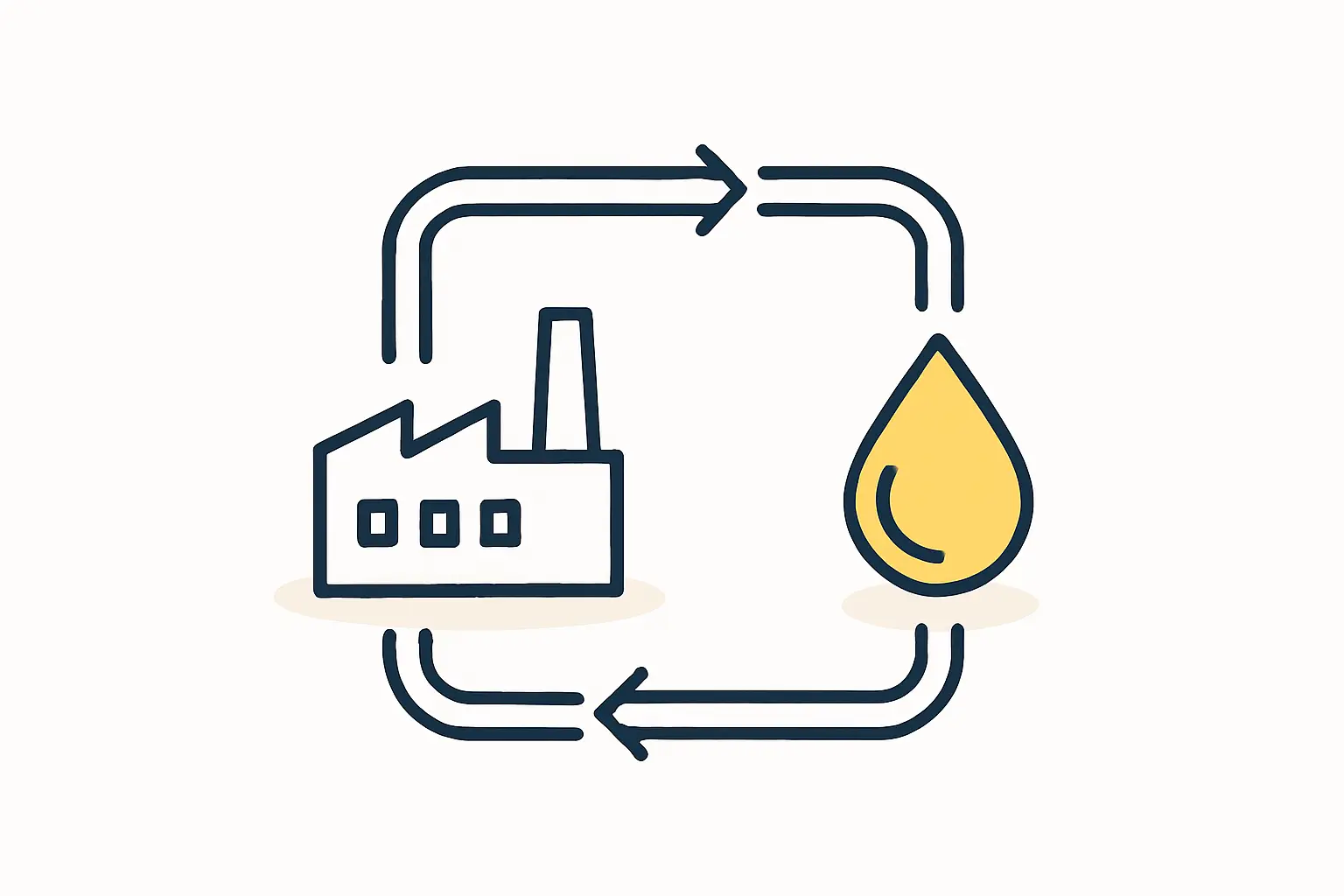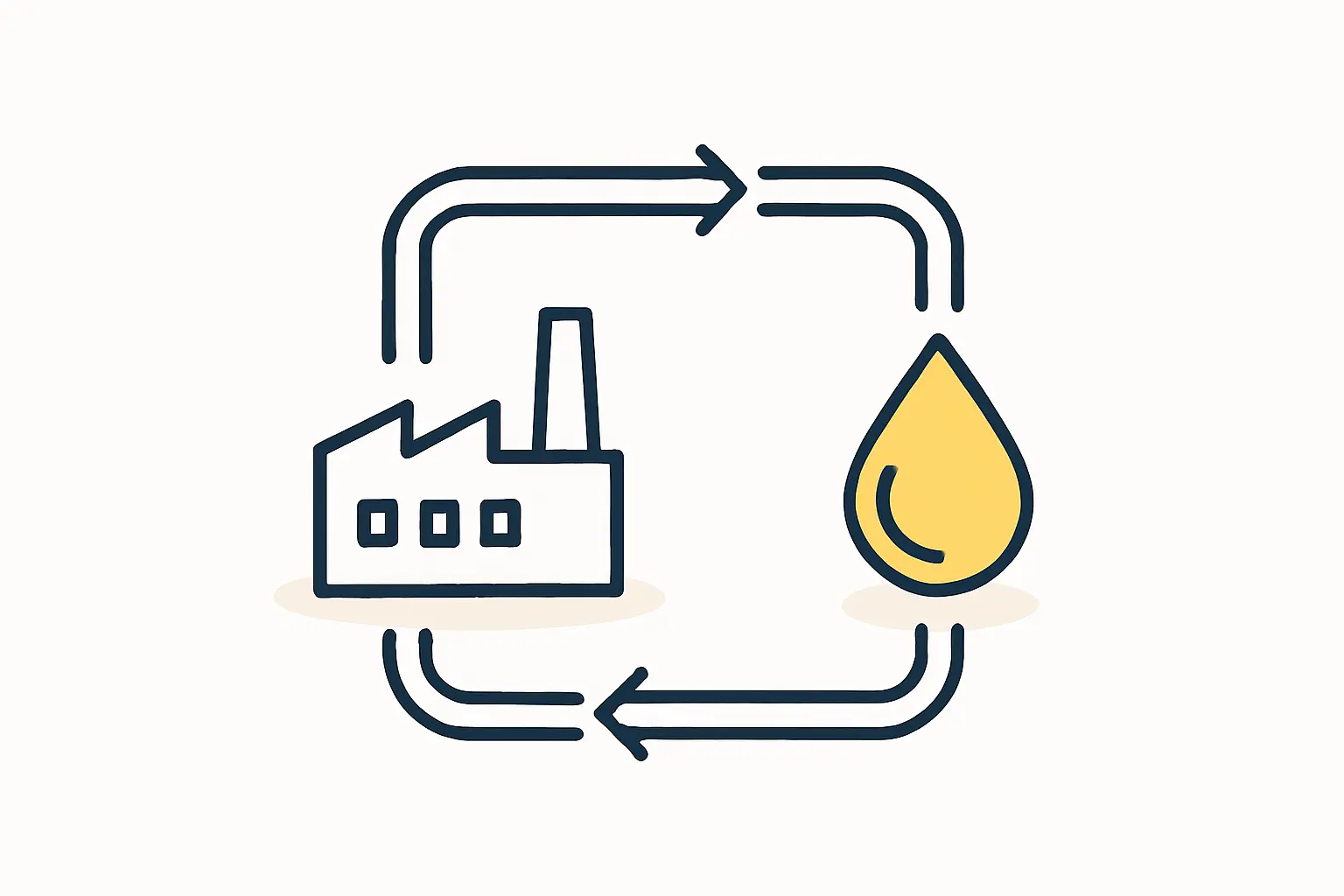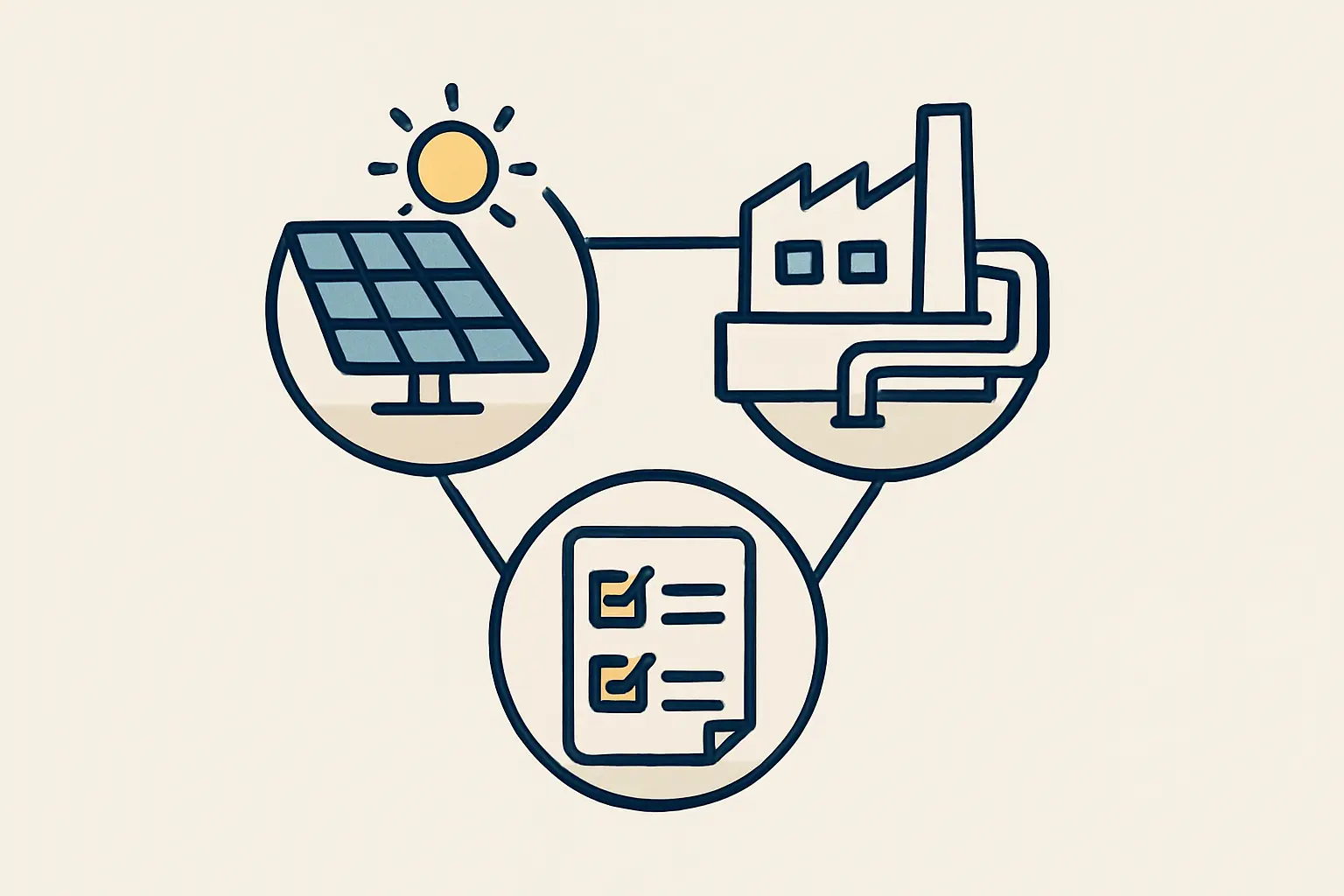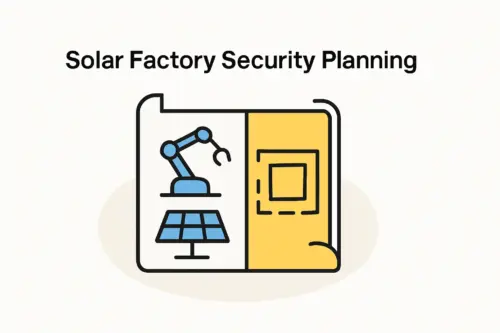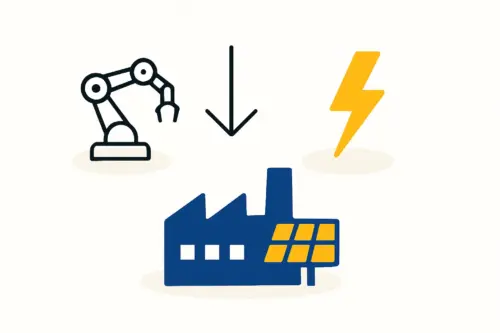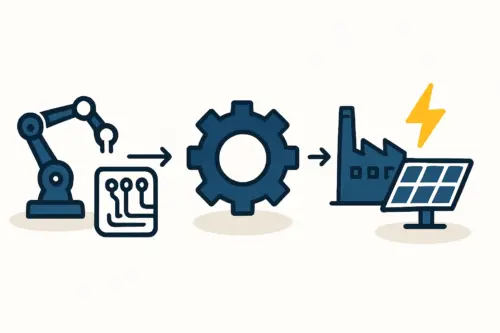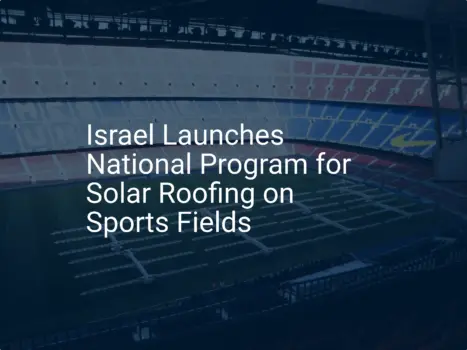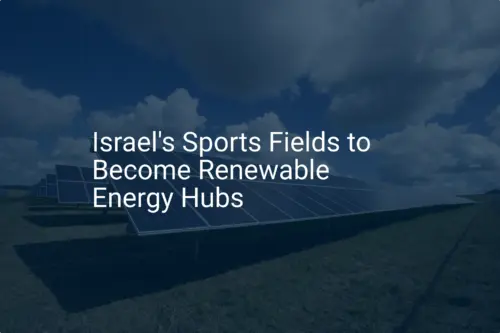An entrepreneur planning to establish a solar panel factory in an arid region, such as southern Israel, faces a compelling paradox. The very location that offers abundant solar energy—the primary resource for the end product—also presents significant operational challenges, namely water scarcity and intense energy demands.
This isn’t just a barrier to entry; it’s a strategic consideration that, when managed correctly, can become a significant competitive advantage.
This guide explores the critical aspects of water and energy management for a solar module manufacturing facility in a dry, high-insolation climate, explaining how the right technologies and regulatory foresight can turn environmental constraints into operational efficiencies.
The Dual Challenge: Water Scarcity and Energy Demands in Solar Manufacturing
A solar module production line requires significant quantities of two key resources: water and electricity. In an arid environment, both come at a premium.
Water is essential for several key processes, primarily washing solar glass before cell stringing and lamination. Cleanliness at this stage is non-negotiable, as any residue can compromise the quality and longevity of the final module. A typical 200 MW factory, for instance, can use up to 4,000 cubic meters of water per month if not managed efficiently.
At the same time, the manufacturing process is energy-intensive. Machinery such as laminators and cell testers consumes a substantial amount of electricity. In many developing or remote regions, the public grid can be unreliable or expensive, posing a risk to continuous 24/7 production schedules.
Strategic Water Management: Beyond Simple Conservation
For a modern solar factory, the solution to water scarcity isn’t just conservation—it’s the implementation of a sophisticated, closed-loop recycling system. This approach is now considered an industry standard for any serious manufacturing venture in a water-stressed region.
How Water Recycling Systems Work in a Solar Factory
A closed-loop system is designed to purify and reuse process water continuously, minimizing the need for fresh intake from municipal sources. The process is both systematic and highly effective:
-
Collection: Wastewater from the glass washing machines and other cleaning stations is collected in a central tank.
-
Filtration: The water undergoes a multi-stage filtration process. This typically includes initial filters to remove larger particles, followed by advanced purification methods like reverse osmosis (RO) to remove microscopic impurities and dissolved solids.
Ready to make big Profits?
The solar Industry is Booming
WE HELP NEWCOMERS to the solar industry start their own solar module production line. Customers can make BIG PROFITS by selling modules and finding investors, without wasting money and time on things they don't need!
-
Quality Control: Sensors continuously monitor the purified water’s quality (e.g., conductivity) to ensure it meets the strict standards required for cleaning solar glass.
-
Re-circulation: The treated water is then pumped back to the production line for reuse.
Advanced systems can recycle over 95% of process water, drastically reducing dependence on external water supplies, lowering operational costs, and ensuring compliance with environmental regulations.
Navigating Environmental Regulations for Industrial Water Use
Governments in arid regions, such as Israel, enforce stringent regulations on industrial water use and wastewater discharge (effluent). Non-compliance can lead to severe financial penalties and operational shutdowns.
A professionally engineered water recycling system ensures that any minimal discharge meets or exceeds local environmental standards. Integrating this system from the initial planning stage is a critical part of a bankable solar manufacturing business plan, showing foresight and operational responsibility to investors and regulatory bodies alike.
Energy Solutions for Manufacturing in High-Insolation Regions
The same abundant sunlight that makes a region ideal for solar energy deployment also offers a solution to the factory’s high energy demands. Using solar power for its own operations allows a manufacturer to achieve significant cost savings and energy independence.
The Role of a Captive Solar Power Plant
A captive solar power plant is an installation—typically on the factory’s rooftop or adjacent land—dedicated to powering the manufacturing facility. This approach turns a major operational expense, electricity, into a controlled, predictable cost.
The benefits are significant:
-
Reduced Operational Costs: Generating electricity on-site significantly lowers reliance on expensive grid power. In many regions, a 1 MW captive solar plant can have a payback period of just 3–5 years.
-
Energy Independence: A captive plant shields the factory from grid instability, power outages, and fluctuating energy prices, ensuring production continuity.
-
Enhanced Brand Value: Manufacturing solar panels with solar power creates a powerful marketing narrative that resonates with environmentally conscious customers globally.
Integrating Energy Storage for 24/7 Operations
Solar power is intermittent by nature. To power a factory around the clock, a captive power plant should be paired with a Battery Energy Storage System (BESS). A BESS stores excess energy generated during peak sunlight hours and releases it during the night or on overcast days. This ensures a stable and uninterrupted power supply for critical machinery, safeguarding the entire production flow.
Case Study Insight: Lessons from Southern Israel
Southern Israel’s Negev Desert serves as an excellent model for this integrated approach. The region is a global hub for solar energy research and deployment, thanks to its high solar irradiation, yet it is also a water-scarce environment with strict environmental laws.
Companies operating here have successfully demonstrated that solar manufacturing is not only viable but can be highly efficient. By adopting best practices in water recycling and deploying captive solar power plants, they have created a blueprint for sustainable industrial development.
The lessons from such projects are invaluable for any entrepreneur developing a project plan for a similar climate, whether in the Middle East, North Africa, or other arid parts of the world. Experience from J.v.G. turnkey projects confirms that planning for these systems from day one is fundamental to success.
Frequently Asked Questions (FAQ)
How much water does a solar panel factory actually use?
Without recycling, a 200 MW production line can consume up to 4,000 cubic meters of fresh water per month. With a state-of-the-art closed-loop recycling system, this fresh water intake can be reduced by over 95%, with new water needed primarily to compensate for minor evaporation losses.
What is the initial investment for a water recycling system?
While a water recycling system requires an initial capital investment, its return on investment (ROI) is typically realized within a few years. The savings come from drastically reduced municipal water bills and the avoidance of potential non-compliance fines. It’s considered a standard and essential component of a modern turnkey production line.
Can a factory run entirely on its own solar power?
Achieving 100% self-sufficiency is technically possible but often isn’t the most practical goal. Most factories aim for maximum self-consumption from their captive solar plant and BESS while maintaining a grid connection for backup. This provides optimal reliability, especially for energy-intensive processes like lamination, ensuring production is never compromised.
Are these solutions applicable outside of the Middle East?
Yes, absolutely. The principles of integrated water and energy management apply to any industrial operation in a water-stressed or high-cost energy environment. These strategies are being successfully implemented in arid regions across North and sub-Saharan Africa, parts of the Americas, and Australia.
Conclusion: Turning Environmental Challenges into a Competitive Advantage
For the discerning entrepreneur, the environmental challenges of an arid climate are not obstacles but opportunities for strategic differentiation. By integrating advanced water recycling and captive solar power generation into the factory’s design from the outset, a manufacturing operation can achieve lower running costs, greater operational resilience, and a stronger brand identity.
Proper planning transforms these regional constraints into a sustainable and profitable business model. Understanding the technical and regulatory nuances is the critical first step. For entrepreneurs ready to take the next step, structured educational resources like the e-courses at pvknowhow.com are designed to provide the in-depth knowledge needed to navigate this complex yet rewarding industry.

